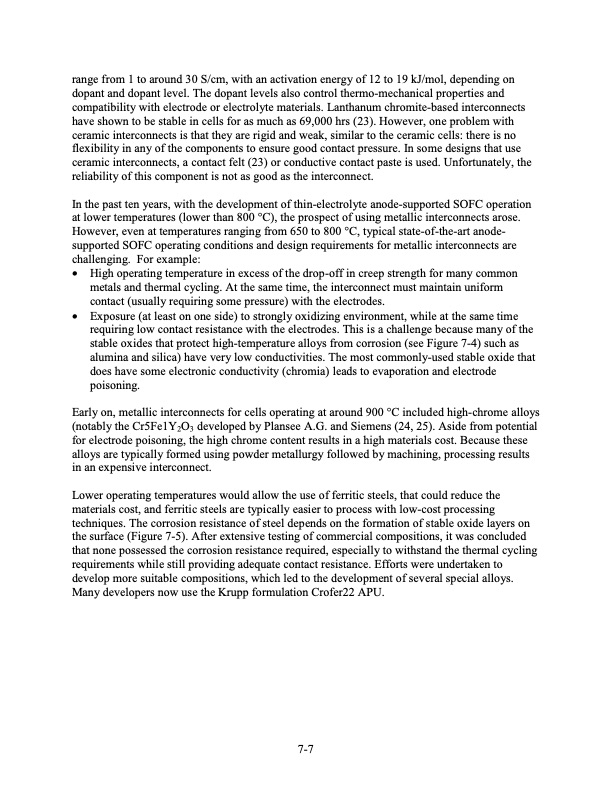
PDF Publication Title:
Text from PDF Page: 203
range from 1 to around 30 S/cm, with an activation energy of 12 to 19 kJ/mol, depending on dopant and dopant level. The dopant levels also control thermo-mechanical properties and compatibility with electrode or electrolyte materials. Lanthanum chromite-based interconnects have shown to be stable in cells for as much as 69,000 hrs (23). However, one problem with ceramic interconnects is that they are rigid and weak, similar to the ceramic cells: there is no flexibility in any of the components to ensure good contact pressure. In some designs that use ceramic interconnects, a contact felt (23) or conductive contact paste is used. Unfortunately, the reliability of this component is not as good as the interconnect. In the past ten years, with the development of thin-electrolyte anode-supported SOFC operation at lower temperatures (lower than 800 °C), the prospect of using metallic interconnects arose. However, even at temperatures ranging from 650 to 800 °C, typical state-of-the-art anode- supported SOFC operating conditions and design requirements for metallic interconnects are challenging. For example: • High operating temperature in excess of the drop-off in creep strength for many common metals and thermal cycling. At the same time, the interconnect must maintain uniform contact (usually requiring some pressure) with the electrodes. • Exposure (at least on one side) to strongly oxidizing environment, while at the same time requiring low contact resistance with the electrodes. This is a challenge because many of the stable oxides that protect high-temperature alloys from corrosion (see Figure 7-4) such as alumina and silica) have very low conductivities. The most commonly-used stable oxide that does have some electronic conductivity (chromia) leads to evaporation and electrode poisoning. Early on, metallic interconnects for cells operating at around 900 °C included high-chrome alloys (notably the Cr5Fe1Y2O3 developed by Plansee A.G. and Siemens (24, 25). Aside from potential for electrode poisoning, the high chrome content results in a high materials cost. Because these alloys are typically formed using powder metallurgy followed by machining, processing results in an expensive interconnect. Lower operating temperatures would allow the use of ferritic steels, that could reduce the materials cost, and ferritic steels are typically easier to process with low-cost processing techniques. The corrosion resistance of steel depends on the formation of stable oxide layers on the surface (Figure 7-5). After extensive testing of commercial compositions, it was concluded that none possessed the corrosion resistance required, especially to withstand the thermal cycling requirements while still providing adequate contact resistance. Efforts were undertaken to develop more suitable compositions, which led to the development of several special alloys. Many developers now use the Krupp formulation Crofer22 APU. 7-7PDF Image | Fuel Cell Handbook (Seventh Edition)

PDF Search Title:
Fuel Cell Handbook (Seventh Edition)Original File Name Searched:
fuel-cell-handbook.pdfDIY PDF Search: Google It | Yahoo | Bing
NFT (Non Fungible Token): Buy our tech, design, development or system NFT and become part of our tech NFT network... More Info
IT XR Project Redstone NFT Available for Sale: NFT for high tech turbine design with one part 3D printed counter-rotating energy turbine. Be part of the future with this NFT. Can be bought and sold but only one design NFT exists. Royalties go to the developer (Infinity) to keep enhancing design and applications... More Info
Infinity Turbine IT XR Project Redstone Design: NFT for sale... NFT for high tech turbine design with one part 3D printed counter-rotating energy turbine. Includes all rights to this turbine design, including license for Fluid Handling Block I and II for the turbine assembly and housing. The NFT includes the blueprints (cad/cam), revenue streams, and all future development of the IT XR Project Redstone... More Info
Infinity Turbine ROT Radial Outflow Turbine 24 Design and Worldwide Rights: NFT for sale... NFT for the ROT 24 energy turbine. Be part of the future with this NFT. This design can be bought and sold but only one design NFT exists. You may manufacture the unit, or get the revenues from its sale from Infinity Turbine. Royalties go to the developer (Infinity) to keep enhancing design and applications... More Info
Infinity Supercritical CO2 10 Liter Extractor Design and Worldwide Rights: The Infinity Supercritical 10L CO2 extractor is for botanical oil extraction, which is rich in terpenes and can produce shelf ready full spectrum oil. With over 5 years of development, this industry leader mature extractor machine has been sold since 2015 and is part of many profitable businesses. The process can also be used for electrowinning, e-waste recycling, and lithium battery recycling, gold mining electronic wastes, precious metals. CO2 can also be used in a reverse fuel cell with nafion to make a gas-to-liquids fuel, such as methanol, ethanol and butanol or ethylene. Supercritical CO2 has also been used for treating nafion to make it more effective catalyst. This NFT is for the purchase of worldwide rights which includes the design. More Info
NFT (Non Fungible Token): Buy our tech, design, development or system NFT and become part of our tech NFT network... More Info
Infinity Turbine Products: Special for this month, any plans are $10,000 for complete Cad/Cam blueprints. License is for one build. Try before you buy a production license. May pay by Bitcoin or other Crypto. Products Page... More Info
| CONTACT TEL: 608-238-6001 Email: greg@infinityturbine.com | RSS | AMP |